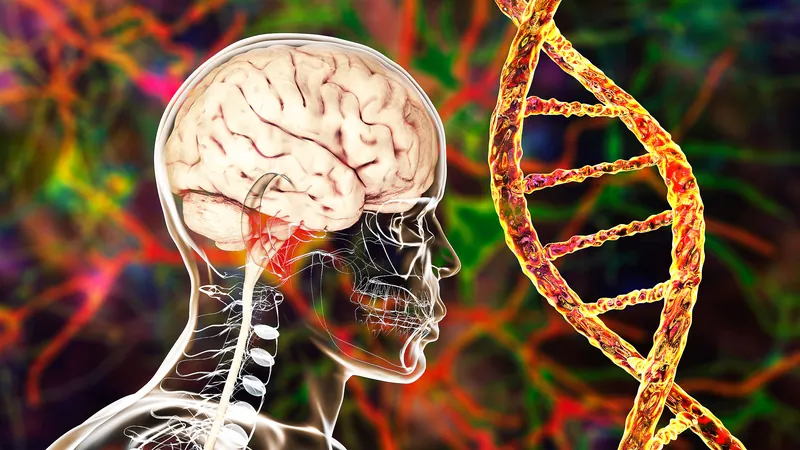
Revelation: Neanderthal DNA May Contribute to Autism Traits in Modern Humans
2025-07-07
Author: Ming
Unearthing the Ancient Connection
Imagine the rugged figure of a Neanderthal: heavy brow, sturdy physique, and a tool-user of stone. Fascinatingly, their DNA continues to pulse within the modern human genome. Groundbreaking research now indicates that certain genetic remnants inherited from these ancient humans could be linked to autism spectrum disorder.
A Journey Through Time
Around 50,000 to 60,000 years ago, small bands of modern humans migrated from Africa into Eurasia, encountering Neanderthals along the way. This meeting was more than just a cultural exchange of tools; interbreeding occurred, allowing genes from Neanderthals to weave into the DNA of modern humans.
It is estimated that populations with Eurasian roots carry about 2% Neanderthal DNA, a remnant of those early minglings. Interestingly, some descendants ventured back to Africa, leaving a sparse but significant trace of Neanderthal genes in the continent.
Genetic Mysteries Revealed
These Neanderthal genetic fragments have proven useful in some cases by enhancing immune responses or aiding survival in high altitudes. However, many of these genetic variants didn't align well with human biology and were selected out over time. Notably, genes influencing brain function are particularly sensitive—small errors can lead to major disruptions.
Linking Autism to Ancient Genetics
The study that establishes a link between autism and Neanderthal DNA was spearheaded by researchers from Clemson University and Loyola University. They meticulously compared complete genome data from individuals on the autism spectrum, their unaffected siblings, and unrelated control participants from various ethnic backgrounds.
Findings revealed that both rare and common Neanderthal-derived genetic variants were more prevalent in those with autism. This isn’t simply about having Neanderthal DNA; it’s about specific segments that influence brain connectivity.
Cognitive Patterns and Traits
Intriguingly, the study highlighted gene variants that impact communication between distant brain regions. Those with higher loads of certain Neanderthal variants exhibited more robust activity in visual processing areas while showing reduced activity in networks typically engaged during social interactions.
This aligns with many autistic individuals who report heightened pattern recognition abilities but experience social fatigue—painting a vivid picture of how these age-old genes might craft a cognitive profile attuned for sharp observation and meticulous planning.
An Evolutionary Puzzle
Why did these particular genetic variants endure? One theory suggests that within the smaller, close-knit groups of Neanderthals, strong visual skills for hunting and resource gathering might have outweighed the demands of complex social interactions. These advantageous traits could have been retained when Homo sapiens interbred with Neanderthals, serving our ancestors well.
Nevertheless, it’s crucial to note that the study does not claim that Neanderthal DNA causes autism. Instead, it posits that certain inherited traits might elevate the chances of developing specific characteristics.
Understanding Neurodiversity
Researchers emphasize that genetics is just one piece of the autism puzzle. Throughout history, environmental factors, early development, and a multitude of genes interact in ways still being explored. What this discovery does is shed light on the universality of autism across different cultures and backgrounds, framing neurodiversity as a reflection of humanity's rich genetic tapestry.
This work offers an exciting link that might explain why families often see patterns of analytical talent—mathematicians, engineers, and artists—scattered among both autistic and non-autistic relatives.
Looking Ahead
The research team expressed hope that these findings will incite more studies into how ancient human genetics influence modern brain development and overall health. Future investigations could delve into various neurodevelopmental conditions, examine how Neanderthal variants mesh with contemporary lifestyles, and refine tailored support systems.
Our understanding of human evolution continues to evolve, weaving the strengths of our ancestors into a rich narrative shaping our modern minds, thoughts, and innovations.
This monumental study was published in the journal Molecular Psychiatry.


 Brasil (PT)
Brasil (PT)
 Canada (EN)
Canada (EN)
 Chile (ES)
Chile (ES)
 Česko (CS)
Česko (CS)
 대한민국 (KO)
대한민국 (KO)
 España (ES)
España (ES)
 France (FR)
France (FR)
 Hong Kong (EN)
Hong Kong (EN)
 Italia (IT)
Italia (IT)
 日本 (JA)
日本 (JA)
 Magyarország (HU)
Magyarország (HU)
 Norge (NO)
Norge (NO)
 Polska (PL)
Polska (PL)
 Schweiz (DE)
Schweiz (DE)
 Singapore (EN)
Singapore (EN)
 Sverige (SV)
Sverige (SV)
 Suomi (FI)
Suomi (FI)
 Türkiye (TR)
Türkiye (TR)
 الإمارات العربية المتحدة (AR)
الإمارات العربية المتحدة (AR)